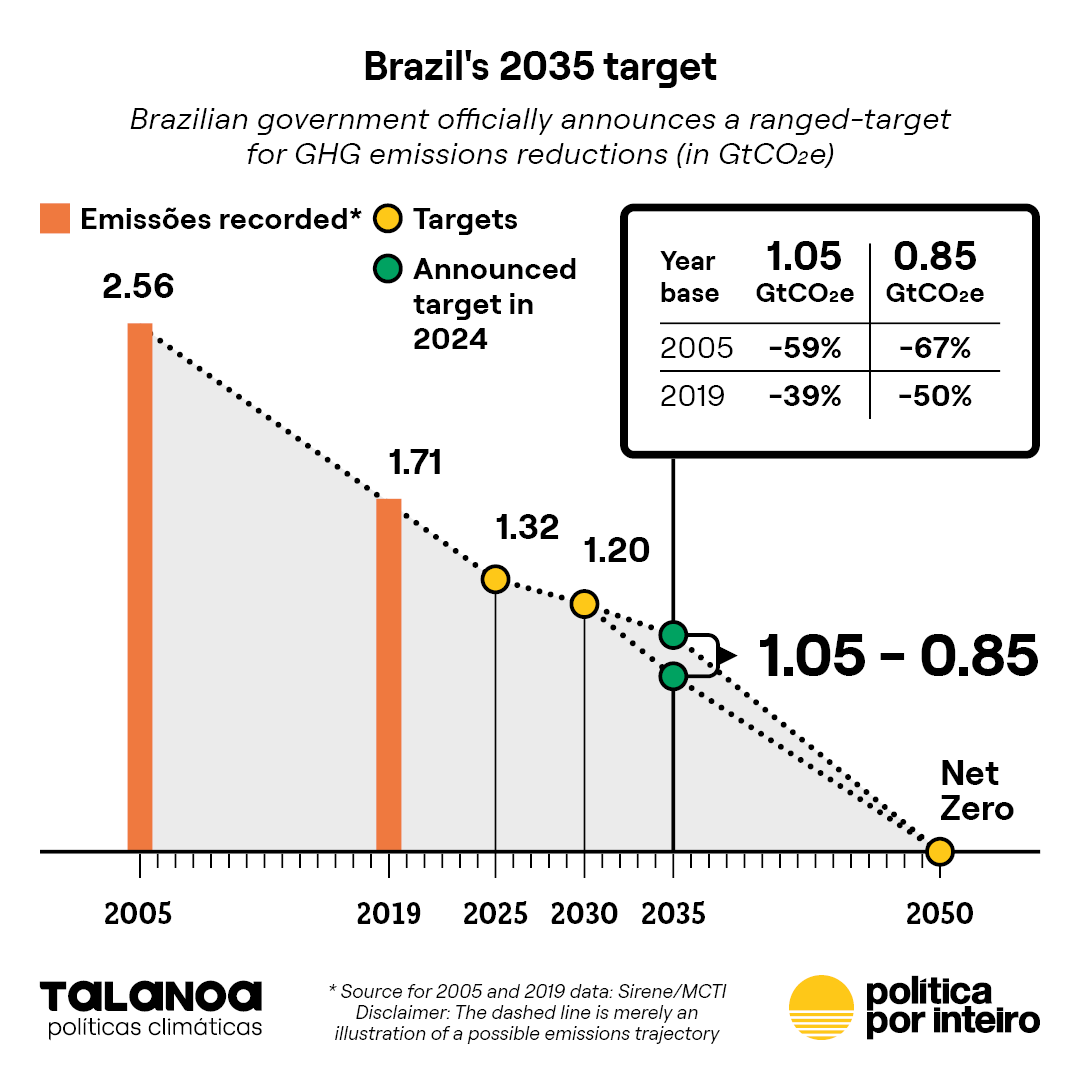Brazil’s NDC paves the way for transition away from fossil fuel and deforestation, but lacks maximum ambition
- Análises, COP29, NDC
- 13 de novembro de 2024
This Wednesday, in Baku, Azerbaijan, Vice President Geraldo Alckmin personally delivered Brazil’s Nationally Determined Contribution (NDC) to Simon Stiell, Executive Secretary of the United Nations Framework Convention on Climate Change (UNFCCC).
The NDC document, now available on the UNFCCC’s NDC Registry portal, spans 44 pages and includes information both on domestic policies as well as the international targets for 2035.
Summary
How to interpret the 2035 target: The NDC sets a target range of 1.05 to 0.85 GtCO2e (GWP AR5) emissions by 2035. This corresponds to 59% to 67% emission reductions by 2035 compared to 2005 levels, which is the base year adopted by Brazil. Notably, for tracking future progress under Article 4.3 of the Paris Agreement, only the upper limit – 59% below 2005 levels (1.05 GtCO2e)—serves as the baseline.
How it compares to the GST: Brazil’s NDC shows progress but lacks maximum ambition, with its 2035 targets falling short of the 60% reduction recommended by the GST. Brazil’s baseline corresponds to 59% to 67% emission reductions in relation to 2005 – a 39% to 50% emission reductions compared to 2019 levels.
Ambition: For the first time, Brazil has openly stated its plan to trade emissions reductions with other countries under the rules of the Paris Agreement. The updated climate target (NDC) sets the upper limit of its 2035 emissions range at 1,050 GtCO2e, making it the threshold for these trades. Any emissions below this limit could be sold to help other countries meet their targets. For Brazil, this creates an incentive to aim for the lower limit of 850 GtCO2e. Globally, however, the impact remains neutral: any reductions credited to one country allow equivalent emissions elsewhere, leaving the total unchanged.
Transition away from fossil fuels: Brazil signals its commitment to Paragraph 28 of the GST by outlining efforts to phase out fossil fuels across sectors through its national energy policy. However, the NDC lacks explicit targets, detailed measures, and clear timelines, failing to strengthen its transparency and long term effectiveness.
Nature: The NDC demonstrates a strong commitment to achieve zero deforestation and plans for large-scale restoration of native vegetation. It reflects recent successes in reducing deforestation rates in key biomes like the Amazon and Cerrado.
Adaptation: For the first time, adaptation is highlighted in the Brazilian NDC. Targets and commitments are yet to be determined, through domestic policies.
Clarity and transparency: While the NDC strives for comprehensiveness, the inclusion of emissions ranges introduces ambiguity, compromising its perceived ambition.
Implementation: The NDC strengthens climate governance by detailing national policy instruments and intergovernmental processes designed to support the achievement of its targets.
Action: The NDC provides a foundation for advancing policies but requires broader societal engagement and clearer commitments to mobilize meaningful action.

Key points of Brazil’s NDC:
Anchored in domestic policies
Unlike previous versions, the NDC presented by the Lula-Alckmin administration outlines a broad vision of efforts and detailed policies to implement mitigation and adaptation commitments. This approach, grounded in domestic policy development, is a welcome step. Ambition alone is not enough — the implementation gap must be closed, both in Brazil and globally.
Committed to a deforestation-free country
On deforestation, Brazil’s primary source of emissions, we acknowledge the positive results in reducing deforestation rates in the Amazon and Cerrado. Brazil’s NDC reflects vision, ambition, and a concrete commitment to ending deforestation this decade, including controlling legal deforestation.
Signals transition away from fossil fuels
Signaling in the NDC a commitment to implementing the Global Stocktake (GST), especially paragraph 28 on transitioning away from fossil fuels, sends a timely message for domestic players. For national purposes, it is crucial to establish the NDC as a guiding framework — particularly for future energy plans and budgets.It also demonstrates that Brazil is ready to position itself as a climate leader among oil, gas, and coal-producing nations. However, the country must go beyond what is stated in the document, working with peers and internally to plan this systemic transformation.
Ambition
On mitigation targets, however, the Brazilian government has not yet presented its maximum ambition. For 2035, the NDC sets an emissions target between 850 and 1,050 million tonnes. However, as indicated in different parts of the submission, the upper limit of 1,050 million tonnes will serve as the basis for reporting progress and for mechanisms under Article 6. Studies by Brazilian organizations suggest that commitments could be deepened, surpassing the 60% emissions reduction from 2019 levels recommended by the GST. Given Brazil’s increased focus on implementation, there is an opportunity to revisit these numbers in due course.
Progression.
A critical aspect of NDCs is the need for progression. Each submission should reflect increased ambition, whether by deepening emission cuts, accelerating the transition from fossil fuels, adopting new policies and measures, or strengthening governance and transparency systems.
The new NDC maintains the emission limits of 1.3 GtCO2e for 2025 and 1.20 GtCO2e for 2030, previously presented. However, the government has introduced new policies and strengthened its implementation capacity. Notably, the reduction in deforestation rates in 2022 and 2023 demonstrates early action toward the 2025 and 2030 mitigation targets.
For 2035, Brazil adopts a target of further emission reductions across all gases and sectors. A range of 1,050 to 850 million tonnes of CO2e for 2035 was presented, representing a reduction of 39–50% from 2019 net emissions (1.712 MtCO2e). However, this falls short to the GST recommendation of reductions of at least 60% by 2035.
The government plans to achieve this level through a combination of policies, technological advances, and investments in bioeconomy, clean energy, and infrastructure.
From a practical and legal standpoint, the upper limit of 1,050 million tonnes will serve as a reference for policy design, including carbon budgeting, market mechanisms, and international transfer of mitigation outcomes (ITMOs).
We consider this insufficient, as it represents limited emission reductions (100 million tonnes) between 2030 and 2035, while the focus is on the ITMOs.
Long-term vision. Another important element is Brazil’s commitment to achieving net-zero emissions by mid-century. Article 4.1 of the Paris Agreement establishes that, in the second half of the century, human emissions and gas removals by natural sinks must be balanced. This long-term goal, combined with the progressive enhancement of NDCs, is essential for achieving climate stability. Brazil’s new NDC maintains its commitment to climate neutrality by 2050.
On the positive side, this target encompasses all greenhouse gases, necessitating significant carbon reductions in the preceding decade, along with much greater efforts to address methane emissions. On the negative side, the Brazilian government missed the opportunity to better define its commitment, continuing to rely on the ambiguous concept of climate neutrality, which assumes a predominant role for offsets and removals in the long-term trajectory. Additionally, Brazil has yet to present a long-term strategy (LTS), remaining one of the three G20 countries with this pending task.
Finally, it is positive that Brazil’s NDC includes a welcome call for developed countries to advance their net-zero targets to 2040 or 2045.
Adaptation and Loss and Damage: The NDC dedicates a specific section to adaptation, signaling its importance and priority. However, it falls short of establishing clear targets or actionable objectives, such as requiring infrastructure investments to incorporate climate risk management and resilience measures. Loss and damage are mentioned only once. These aspects should be further elaborated within the Climate Plan and integrated into national infrastructure investment programs.
Transparency
Brazil’s NDC includes all gases listed in the Kyoto Protocol, covers all sectors, sets unconditional targets, and provides transparency on how its submission reflects a fair share of effort. Its preparation was based on the best available science.
However, as mentioned earlier, it lacks measurable commitments with specific deadlines and mechanisms for independent monitoring.
Participation
Brazil’s NDC did not undergo a broad and inclusive consultation process with society regarding its content. Only a general consultation on climate policy took place, with an ongoing consultation on the adaptation strategy. To ensure support for NDC implementation and encourage subnational and corporate targets aligned with short- and long-term goals, it must gain legitimacy from Brazilian society. The NDC states: “The Climate Plan will establish an integrated vision for the national climate agenda, engaging the federal government, states, the Federal District, and municipalities, along with civil society, the private sector, and the scientific community, in response to the climate crisis.” We expect this promise to be fulfilled, strengthening the vision with the implementation of national targets involving states, municipalities, consortia, and other arrangements, alongside regulation of economic agents.
Transition away from fossil fuels: Brazil signals its commitment to Paragraph 28 of the GST by outlining efforts to phase out fossil fuels across sectors through its national energy policy. However, the NDC lacks explicit targets, detailed measures, and clear timelines, failing to strengthen its transparency and long term effectiveness.
Nature: The NDC demonstrates a strong commitment to achieve zero deforestation and plans for large-scale restoration of native vegetation. It reflects recent successes in reducing deforestation rates in key biomes like the Amazon and Cerrado.
Quotes
Natalie Unterstell, president, Instituto Talanoa
”The 2035 target demonstrates Brazil’s progress, but we must keep raising the bar. Ambition anchored in 1.05 GtCO2e should be a stepping stone, not a ceiling, in our climate leadership. Brazil’s intention to sell ITMOs must complement – not substitute – ambitious emissions reductions at home.”
“Brazil’s efforts to address deforestation and restoration signal hope, but meeting the global stocktake demands more ambition and faster actions across all sectors.”
“Brazil is a first mover with its 2035 NDC and demonstrates an impressive track record in reducing emissions from deforestation. Now, it’s time for the country to take bold steps toward implementing the transition away from fossil fuels and inspire other producing countries to follow suit.”
 Versão em português
Versão em português



